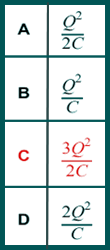Capacitors - Multiple Choice Q21. A parallel-plate capacitor is fully charged and then disconnected from the power supply. A dielectric is then inserted between the plates. Which row correctly identifies the charge on the plates and the electric field strength between the plates?
Choice D
Q22. A capacitor of capacitance C has a charge of Q stored on the plates. The potential difference between the plates is doubled. What is the change in the energy stored by the capacitor?
C = Q/V Q is constant - V doubles - so C will halve E1 = ½CV2 E2 = ½C(2V)2 = ½CV2 x 4 = 2CV2 E2 - E1 = 2CV2 - ½CV2 = 3/2CV2 But V = Q/C so: E2 - E1 = 3/2C(Q/C)2 E2 - E1 = 3/2 Q2/C Choice C Q23. A capacitor consists of two parallel square plates of side l separated by distance d. The capacitance of the arrangement is C. What is the capacitance of a capacitor with square plates of side 2l separated by a distance ½d ?
C = Aε0εr/d A (proportional)increases by a factor of 4 to C increases by a factor of 4 d (inversely proportional) decreases by a factor of 2, to C increases by a factor of 2 Combine factors - 4 x 2 = 8 Choice D
Q24. A capacitor of capacitance 120 µF is charged and then discharged through a 20 kΩ resistor. What fraction of the original charge remains on the capacitor 4.8 s after the discharge begins?
Q = Q0(1 - e-t/RC) Q /Q0= 1 - e-t/RC t/RC = 4.8/(20 x 103 x 120 x 10-6) = 2 Q /Q0= 1 - e-2 Q /Q0 = 0.86 Therefore 86% of the charge has been discharged after that time - this leaves 14% still on the capacitor. Choice A |
Follow me...
|







